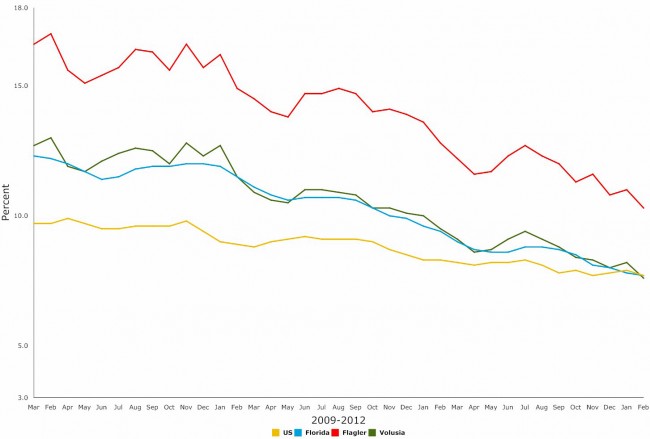
Flagler County’s unemployment rate fell sharply in February, to 10.3 percent–from 11 percent the previous month–and matched its lowest level since August 2008. Florida’s unemployment rate also continued to fall, matching the national rate, at 7.7 percent, in February while adding 7,800 jobs.
Flagler continues to rank among the counties with the highest unemployment rate, but it is now tied for second-worst, with Putnam County. Hendry has the highest unemployment rate, at 10.8 percent. Flagler’s is approaching that of Miami-Dade (9.4 percent), St. Lucie (9.5), Hamilton and Dixie (9.4).
Other good signs for Flagler: the labor force stayed flat at just over 34,850, but the number of people with jobs grew by 270, to 31,268, while the number of people without work fell by 251. In many previous months, the declining unemployment rate was driven more by a shrinking labor force rather than by net job creation.
Five years ago–in February 2008–Flagler County’s unemployment rate was 7.4 percent. Its labor force was 11 percent smaller, or by almost 4,000 people, and it had 28,600 people with jobs. In other words, even as the recession struck and the economy’s woes deepened, the county added 2,668 jobs in the interim. That suggests that while thousands of jobs were lost in housing, real estate, construction and related trades, thousands of new jobs were created in other fields.
The number of people without jobs is also instructive: that number stood at 2,288 five years ago. It was 3,597 last February–a 57 percent increase over the five years. But the number is amplified because of proportions: St. Johns County has consistently had lower unemployment rates than Flagler, and some of the healthiest employment rates in the state. But even today, with an unemployment rate at 5.8 percent, St. Johns is contending with 5,822 people without work, though its labor force of 101,000 is almost three times that of Flagler.
The figures for Florida are also striking. While the state unemployment rate continues to fall, there are still 91,000 fewer people with jobs, overall, today than there were five years ago. The state’s overall labor force has not increased significantly in the interim, growing by just 2 percent in five years. In other words, for all of Gov. Rick Scott’s talk of a state and a job-creation machinery on the mend, Florida has yet to recover the job it lost in the Great Recession, as the national economy did last year.
Some 7.5 million Floridians are employed, against 729,000 officially jobless Floridians. The figure does not include those who have quit looking for work, or those working part time because their hours have been cut back or because they can’t find full-time work.
Looking closer at the February jobs report, the numbers are again as middling as in January, with most industries showing outright big gains or losses. The largest overall gain was in education services, whose 2.2 percent gain in jobs translated to 3,100 new jobs. The biggest loss was in construction, where a 1.5 percent drop meant that 5,300 jobs were lost. Some 342,000 Floridians are employed in construction. There was a 0.8 percent drop in goods producing (or 5,500 jobs). On the plus side, the state added 13,300 jobs to its biggest sector–services, which employ 6.8 million people.
Some area highlights compiled by the Center for Business Excellence in Daytona Beach:
The unemployment rate in the Center for Business Excellence region (Flagler and Volusia counties) was 7.9 percent in February 2013. The February 2013 rate was 2.0 percentage points lower than the region’s year-ago rate. The state unemployment rate was 0.4 percentage point lower than the region at 7.5 percent. Out of a labor force of 284,390, there were 22,603 unemployed residents in the region.
Nonagricultural employment in the Palm Coast metro area (Flagler County) was 20,000 in February 2013. Total nonagricultural employment was up 200 jobs (+1.0 percent) over the year. Statewide, employment increased by 1.9 percent over the same time period.
Three of the ten major industries gained jobs over the year, led by professional and business services (+300 jobs); leisure and hospitality (+200 jobs); and mining, logging, and construction (+100 jobs). Manufacturing, information, other services, and government (-100 jobs each) lost jobs over the year. Education and health services and financial activities remained unchanged over the year.
Professional and business services (+15.0 percent); mining, logging, and construction (+12.5 percent); and leisure and hospitality (+6.7 percent) employment grew faster in the Palm Coast metro area than in the state. The Palm Coast metro area had the highest employment growth rate in professional and business services (+15.0 percent) for all metro areas in Florida.
![]()
Florida Unemployment Report, February 2013





























Dave says
I have been turned down 102 times this past year looking for work. They keep telling me I have to take a drug test. I keep telling them, Oh no problem, I will Ace that test cause I take all kinds of drugs. Then they escort me to the door. I just don’t understand this New Society’s work ethics !